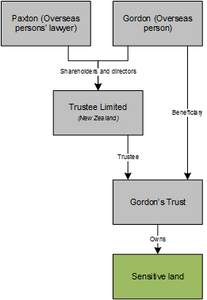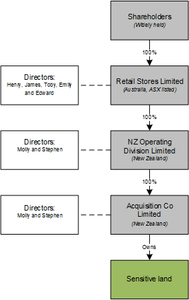The ‘relevant overseas person’ (ROP) and ‘individuals with control of the relevant overseas person’ (IWC) are concepts used in the Overseas Investment Act 2005 (the Act) to focus our assessment on the entities and individuals behind an investment.
These concepts reflect the commercial reality that for many investments, looking at the person or entity purchasing an asset will be insufficient. It is necessary to look through them to identify ultimate ownership and control.
Definitions
Relevant overseas person
The power to determine the individuals and entities which make up the ROP in relation to an investment is designed to allow us to decide who is in substance the investor in New Zealand.
Individuals with control
The power to determine who are the IWCs are in relation to an investment is designed to allow us to decide who are in substance the individuals who control the ROP (where an ROP is not an individual).
Why is it important?
ROP or IWC selection is important as it determines who we will assess against the investor test.
It can also influence our assessment as to whether the investment will benefit New Zealand (referred to as the benefit test) as some benefit factors focus on the ROP.
Our approach to ROP or IWC selection
We will have regard to ownership and control information you provide and be targeted in our selection of the ROP or IWC where we consider it reasonable to do so. How much we rely on your information, and how targeted we can be, will be determined by the adequacy of that information and the risk profile of your application. For example, our approach to ROP or IWC selection for a new investor is likely to be different than for a repeat investor with a track record of compliance and delivery of benefits in New Zealand.
Things to note
- ROP is a collective term that may cover more than one individual or entity.
- We must determine who the ROP and IWCs are for the specific investment being made. ROP selection for a particular investor may differ depending on the nature of the investment.
- Our discretion to select the ROP and IWCs under the Act is deliberately wide so we may focus on the substance rather than the form of the applicant’s ownership and control structure.
- Full ownership and control information and well-reasoned ROP or IWC submissions are of critical importance to our assessment process. We will not accept your application for assessment if your information is incomplete, unreliable or otherwise inadequate. This may also increase the risk profile of your application.
- It is an offence to make a false or misleading statement or material omission in any information you provide to us.
How we select the ROP or IWC
Where individuals are making a direct investment, in their own names and for their own benefit, we will normally select them as the ROP. There will normally be no IWCs if all of the ROPs are individuals.
There are additional matters to consider when selecting the ROP and IWCs for investments by entities. The information below relates primarily to these types of investments.
Ownership and control information
Where an investment is being made by an entity (the acquiring entity), we will first seek to understand upstream ownership and control of that entity before selecting the ROP and IWCs. Your ownership and control information must:
- identify the acquiring entity and trace ownership and control of that entity back to ultimate beneficial owners or controllers
- identify the role and significance of different intermediary entities and other parties (including associates) holding a direct or indirect interest in the acquiring entity
- explain why ownership arrangements (for example limited partnerships, different share classes or trust arrangements) have been used, demonstrating that there are legitimate commercial reasons for them, and how they work
- address the following questions:
- Who is providing the required business experience and acumen?
- Where is the financial commitment (funding) coming from?
- Who approved the acquisition of the investment and who could approve its divestment?
- Who is responsible for the day-to-day management of the investment?
- Who can approve significant capital and operating expenditure?
- Are there formal (or informal) decision making delegations in place? Who controls those delegations?
Our application templates contains further guidance on the information you must provide us with.
Selecting the ROP
Once we have a full understanding of ownership and control, we will consider which entities or individuals should make up the ROP. We will focus on:
- ownership and control for the investment being made – ROP selection for a particular investor may differ depending on the nature of the investment (for example, whether it is a major or minor investment for the applicant)
- substance over form – we will look through legal structures and focus on true ownership and control (for example, we may exclude from the ROP special purpose vehicles, shell companies and corporate trustees)
- significant interests – the lesser the interest an entity or individual has in an investment the less likely they will be an ROP (for example, we may exclude from the ROP those with 25% and less ownership or control and those who are not in a position to influence the investment).
For large entities, such as multinational corporations, we will have regard to:
- the level of control to be exercised over the investment by upstream owners or controllers (for example, we may exclude upstream owners or controllers from the ROP if they are so far removed from the investment that they will have little or no influence over it)
- the scale and autonomy of lower level entities (for example, in some cases we may focus on a New Zealand operating entity rather than upstream owners or controllers).
Selecting IWCs
To the extent that the ROP includes entities, we will then consider which individuals have control of each ROP entity. We will focus on:
- individuals with control of the ROP for the investment being made
- how important decisions are made within the ROP for the investment
- individuals with a more than 25% ownership and control interest in the ROP
- substance over form.
Example 1 – Trust

| Acquiring entity | Trustee Limited as trustee of Gordon’s Trust |
|---|---|
| Investment | Gordon wishes to acquire a lifestyle block using his trust |
| Ownership or control | Gordon is the settlor and sole beneficiary of the trust. Gordon has control over the appointment and removal of trustees and beneficiaries under the trust deed. Gordon is a shareholder and director of the trustee company. Paxton is Gordon’s lawyer and has no beneficial interest in the trust and is a shareholder and director of Trustee Limited in a professional capacity only. |
| Relevant overseas person | Gordon (as the person behind the investment). Trustee Limited (as the acquiring entity) |
| Individuals with control | Gordon – NA, Gordon is an individual Trustee Limited – Gordon is the individual with control of Trustee Limited. Paxton has been excluded as he is acting in a professional capacity only and has no real control over the investment. |
Example 2 – Australasian Retail Business

| Acquiring entity | Acquisition Co Limited Acquisition Co Limited is part of the ‘Retail Stores’ group of companies, an Australasian retail chain with a significant existing presence in New Zealand. Retail Stores regularly buys land, using it to build and operate new stores. The company is also looking to expand its New Zealand footprint by acquiring other companies already operating in New Zealand. Retail Stores is a quality investor with a track record of beneficial investments and compliance with consent conditions. |
|---|---|
| Investment | Investment 1: Acquisition Co Limited wishes to acquire sensitive land to develop a new retail store (Investment 1). Investment 2: Acquisition Co Limited wishes to acquire 100% of the shares of another retail store operator in New Zealand (Investment 2). |
| Ownership or control | Retail Stores Limited is an Australian ASX listed company The shares in Retail Stores Limited are widely held (no single shareholder owns more than 5% of its shares). NZ Operating Division Limited has responsibility for the operation of the New Zealand business including the development of new stores. NZ Operating Division Limited plans, approves and funds new stores with little involvement of the parent company. Larger investments and more strategic decisions such as the acquisition of other retail businesses in New Zealand are planned, approved and funded by Retail Stores Limited. NZ Operating Division Limited will be responsible for the operation of any new acquisitions going forward. |
| Relevant overseas person | Investment 1:
Investment 2:
|
| Individuals with control | Investment 1:
Investment 2:
|